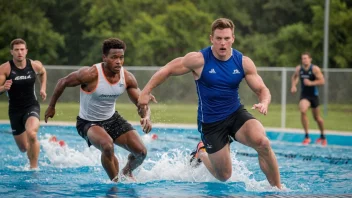Concussions are a growing concern in contact sports like football and rugby, where head injuries can occur frequently. Helmets are designed to protect athletes from traumatic brain injuries, but their effectiveness in preventing concussions is often debated. This article aims to address common questions regarding the role of helmets in concussion prevention and their importance in sports safety.
What is a concussion?
A concussion is a type of traumatic brain injury caused by a blow to the head or body, which causes the brain to move rapidly inside the skull. Symptoms can include confusion, headaches, dizziness, and memory issues. It's crucial for athletes to recognize the signs of a concussion and seek immediate medical attention.
How do helmets help prevent concussions?
Helmets are designed to absorb impact and reduce the forces transmitted to the skull during a collision. They provide a protective barrier that can help minimize the risk of severe head injuries. However, while helmets can reduce the risk of skull fractures and lacerations, they are not a foolproof solution against concussions.
Do all helmets provide the same level of protection?
No, not all helmets are created equal. Different helmets are designed for specific sports and levels of play. The safety standards set by organizations such as the National Operating Committee on Standards for Athletic Equipment (NOCSAE) ensure that helmets meet certain performance criteria. Athletes should choose helmets that are specifically tested and rated for their sport.
Can wearing a helmet lead to risky behavior in sports?
Some studies suggest that athletes may engage in riskier behavior when wearing helmets, a phenomenon known as risk compensation. They may feel more invulnerable and may take unnecessary risks, believing that the helmet will protect them. It’s essential for athletes to understand that while helmets provide protection, they do not eliminate the risk of concussions entirely.
What additional precautions can be taken to prevent concussions?
In addition to wearing properly fitted helmets, athletes can take several other precautions to minimize the risk of concussions. These include:
- Understanding and following the rules of the game to avoid dangerous plays.
- Participating in conditioning programs that focus on strengthening neck muscles, which can help stabilize the head.
- Ensuring proper tackling techniques and body control during play.
- Staying informed about the signs of concussions and encouraging teammates to report any symptoms.
How often should helmets be replaced?
Helmets should be replaced regularly, as they can degrade over time due to wear and tear. Many manufacturers recommend replacing helmets every 3-5 years, but if a helmet has been involved in a significant impact, it should be replaced immediately, regardless of its age. Regular inspections can help ensure that helmets remain in safe condition.
What role does technology play in improving helmet safety?
Advancements in sports technology have led to the development of better helmet designs that incorporate materials and features aimed at reducing impact forces. Some helmets now include sensors that can monitor impacts and alert coaching staff if an athlete has experienced a hit that could lead to a concussion. Ongoing research continues to improve helmet safety standards and design.
Are there any guidelines for helmet fitting?
Proper helmet fitting is crucial for ensuring maximum protection. Here are some guidelines for fitting a helmet:
- The helmet should sit level on the head and not rock back and forth.
- The front of the helmet should be about an inch above the eyebrows.
- The chin strap should be snug but not too tight, allowing for comfortable movement.
- Check for any gaps between the helmet and the head; there should be minimal space.
What should athletes do if they suspect a concussion?
If an athlete suspects they have sustained a concussion, they should immediately inform their coach and seek medical evaluation. It's crucial to follow the appropriate return-to-play protocols, which often involve a gradual increase in activity under medical supervision.
In conclusion, while helmets play a vital role in protecting athletes from head injuries in sports like football and rugby, they are not a complete safeguard against concussions. Athletes, coaches, and parents must prioritize safety by understanding the limitations of helmets and taking additional precautions to reduce the risk of head injuries. Awareness, proper training, and adherence to safety protocols are essential in creating a safer sporting environment.






